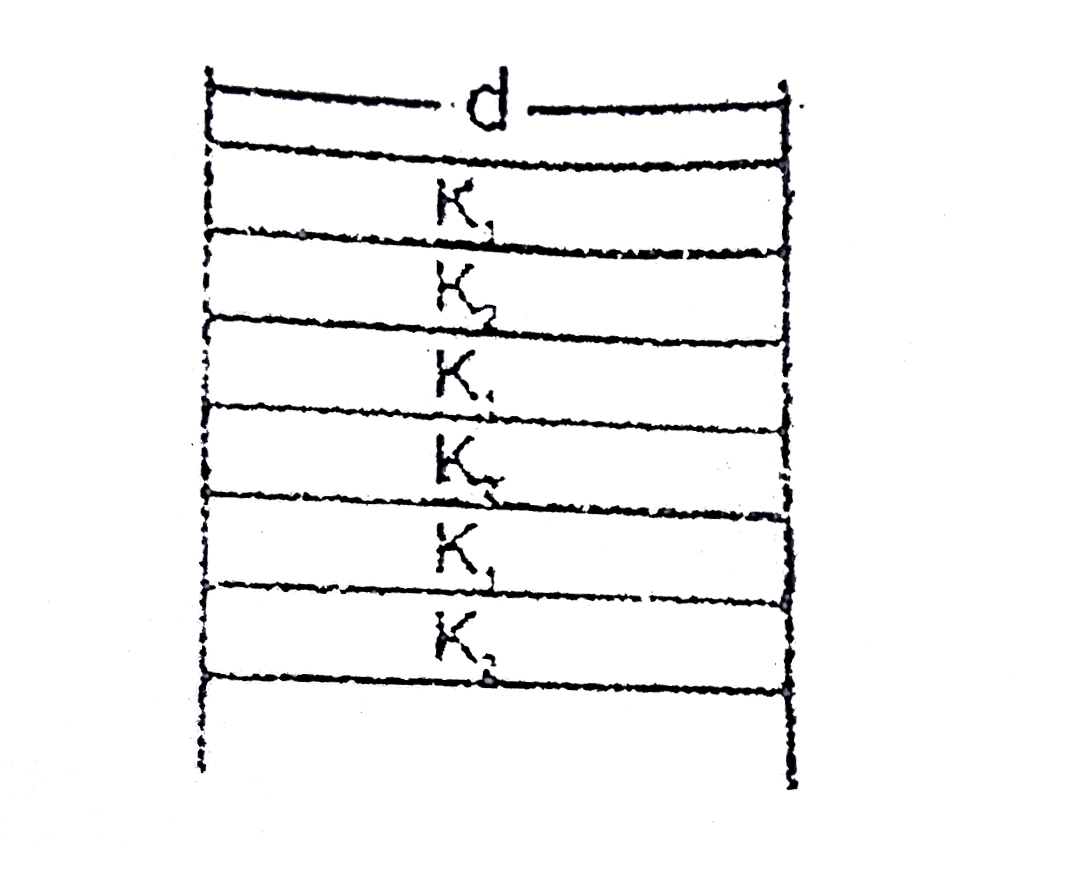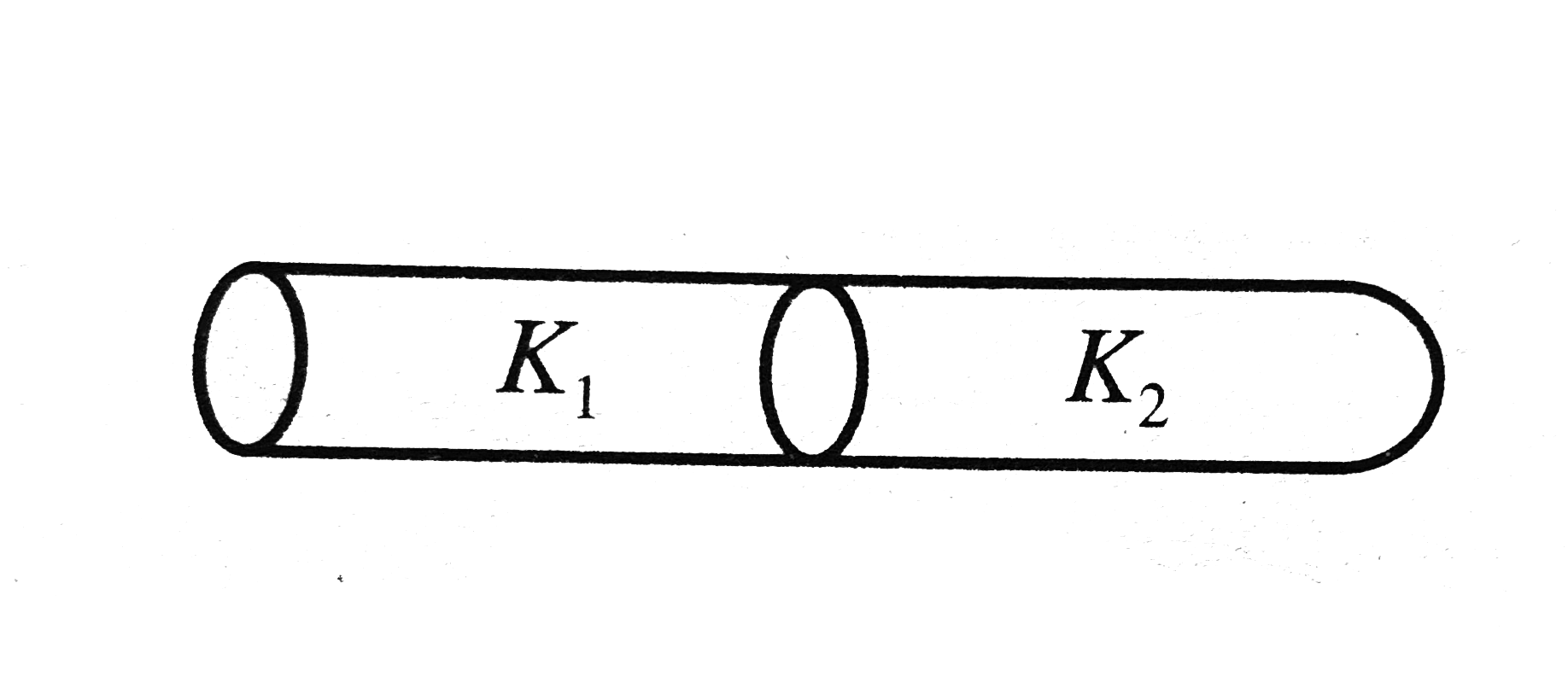Two rods of length d1 and d2 and coefficients of thermal conductivites K1 and K2 are kept touching each other. Both have the same area of cross-section. The equivalent thermal conductivity.
K1d1+K2d2
K1+K2
K1d1+K2d2d1+d2
d1+d2(d1K1)+(d2K2)
The correct Answer is:D
To find the equivalent thermal conductivity of two rods in contact, we can follow these steps:
1. Identify the Parameters:
- Let the lengths of the two rods be d1 and d2.
- Let the thermal conductivities of the two rods be K1 and K2.
- Both rods have the same area of cross-section, denoted as A.
2. Calculate Thermal Resistance:
- The thermal resistance R for a rod is given by the formula:
R=dK⋅A
- For rod 1:
R1=d1K1⋅A
- For rod 2:
R2=d2K2⋅A
3. Total Thermal Resistance:
- Since the rods are in series, the total thermal resistance Rtotal is the sum of the individual resistances:
Rtotal=R1+R2=d1K1⋅A+d2K2⋅A
4. Combine the Resistances:
- Factor out A from the equation:
Rtotal=1A(d1K1+d2K2)
5. Relate Total Resistance to Equivalent Conductivity:
- The equivalent thermal resistance can also be expressed in terms of the equivalent thermal conductivity Keq:
Rtotal=dtotalKeq⋅A
- Here, dtotal=d1+d2.
6. Set the Two Expressions for Resistance Equal:
- Equating the two expressions for Rtotal:
d1+d2Keq⋅A=1A(d1K1+d2K2)
7. Cancel out Area A:
- Since A is the same for both rods, we can cancel it out:
d1+d2Keq=d1K1+d2K2
8. Solve for Keq:
- Rearranging gives:
Keq=(d1+d2)⋅(K1⋅K2)d1⋅K2+d2⋅K1
Final Result:
The equivalent thermal conductivity Keq is given by:
Keq=(d1+d2)⋅(K1⋅K2)d1⋅K2+d2⋅K1
- Let the lengths of the two rods be d1 and d2.
- Let the thermal conductivities of the two rods be K1 and K2.
- Both rods have the same area of cross-section, denoted as A.
- The thermal resistance R for a rod is given by the formula:
R=dK⋅A
- For rod 1:
R1=d1K1⋅A
- For rod 2:
R2=d2K2⋅A
- Since the rods are in series, the total thermal resistance Rtotal is the sum of the individual resistances:
Rtotal=R1+R2=d1K1⋅A+d2K2⋅A
- Factor out A from the equation:
Rtotal=1A(d1K1+d2K2)
- The equivalent thermal resistance can also be expressed in terms of the equivalent thermal conductivity Keq:
Rtotal=dtotalKeq⋅A
- Here, dtotal=d1+d2.
- Equating the two expressions for Rtotal:
d1+d2Keq⋅A=1A(d1K1+d2K2)
- Since A is the same for both rods, we can cancel it out:
d1+d2Keq=d1K1+d2K2
- Rearranging gives:
Keq=(d1+d2)⋅(K1⋅K2)d1⋅K2+d2⋅K1
The equivalent thermal conductivity Keq is given by:
Keq=(d1+d2)⋅(K1⋅K2)d1⋅K2+d2⋅K1
Topper's Solved these Questions
- CALORIMETRY AND HEAT TRANSFERBook:DC PANDEY ENGLISHChapter:CALORIMETRY AND HEAT TRANSFERExercise:Match the columns
Explore 4 Videos
- CALORIMETRY & HEAT TRANSFERBook:DC PANDEY ENGLISHChapter:CALORIMETRY & HEAT TRANSFERExercise:Level 2 Subjective
Explore 14 Videos
- CENTRE OF MASSBook:DC PANDEY ENGLISHChapter:CENTRE OF MASSExercise:Medical entrances gallery
Explore 27 Videos
Similar Questions
A wall consists of alternating blocks withlength 'd' and coefficient of thermal conductivity k1 and k2. The cross sectional area of the blocks are the same. The equivalent coefficient of thermal conductivity of the wall between left and right is:-

View SolutionA composite slab is prepared by pasting two plates of thickness L1 and L2 and thermal conductivities K1 and K2 . The slab have equal cross-sectional area. Find the equivalent conductivity of the composite slab.
View Solution
Knowledge Check
Two rods of length l1andl2 and coefficients of thermal conductivities k1andK2 are kept touching each other. Both have the same area of cross-section. The equivalent of thermal conductivity is
AK1+K2BK1l1+K2l2CK1l1+K2l2l1+l2Dl1+l2(l1/K1)+(l2/K2)IF two metallic plates of equal thickness and thermal conductivities K1andK2 are put together face to face anda common plate is constructed, then the equivalent thermal conductivity of this plate will be
AK1K2K1+K2B2K1K2K1+K2C(K21_K22)3/2K1K2D(K21+K22)3/22K1K2Two walls of thickness d1andd2 and thermal conductivites K1andK2 are in contact. In the steady state, if the temperature at the outer surfaces are T1andT2 the temperature at the common wall is
AK1T1d2+K2T2d1K1d2+K2d1BK1T1+K2T2d2+d1C(K1d1+K2d2T1+T2)T1T2DK1T1d1+K2T2d2K1d1+K2d2

Statement I: Two solid cylindrical rods of identical size and different thermal conductivity K1 and K2 are connected in series. Then the equivalent thermal conductivity of two rods system is less than that value of thermal conductivity of either rod.
Statement II: For two cylindrical rods of identical size and different thermal conductivity K1 and K2 connected in series, the equivalent thermal conductivity K is given by 2K=1K1+1K2
View Solution
Statement I: Two solid cylindrical rods of identical size and different thermal conductivity K1 and K2 are connected in series. Then the equivalent thermal conductivity of two rods system is less than that value of thermal conductivity of either rod.
Statement II: For two cylindrical rods of identical size and different thermal conductivity K1 and K2 connected in series, the equivalent thermal conductivity K is given by 2K=1K1+1K2
View SolutionTwo bodies of masses m1 and m2 and specific heat capacities S1 and S2 are connected by a rod of length l, cross-section area A, thermal conductivity K and negligible heat capacity. The whole system is thermally insulated. At time t=0 , the temperature of the first body is T1 and the temperature of the second body is T2(T2>T1) . Find the temperature difference between the two bodies at time t.
View SolutionTwo bodies of masses m1 and m2 and specific heat capacities S1 and S2 are connected by a rod of length l, cross-section area A, thermal conductivity K and negligible heat capacity. The whole system is thermally insulated. At time t=0 , the temperature of the first body is T1 and the temperature of the second body is T2(T2>T1) . Find the temperature difference between the two bodies at time t.
View SolutionTwo bars of same length and same cross-sectional area but of different thermal conductivites K1 and K2 are joined end to end as shown in the figure. One end of the compound bar it is at temperature T1 and the opposite end at temperature T2 (whereT1>T2). The temperature of the junction is

View Solution
